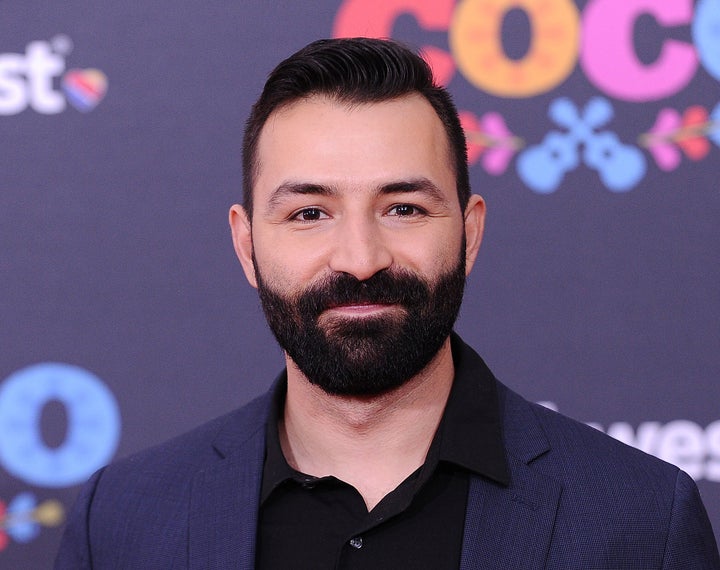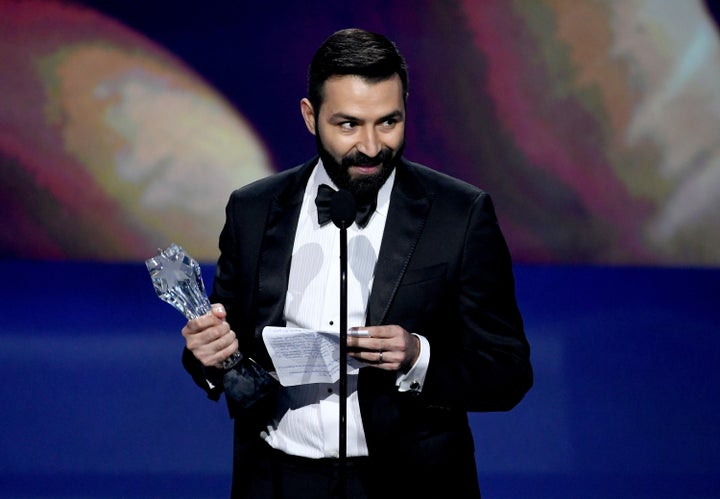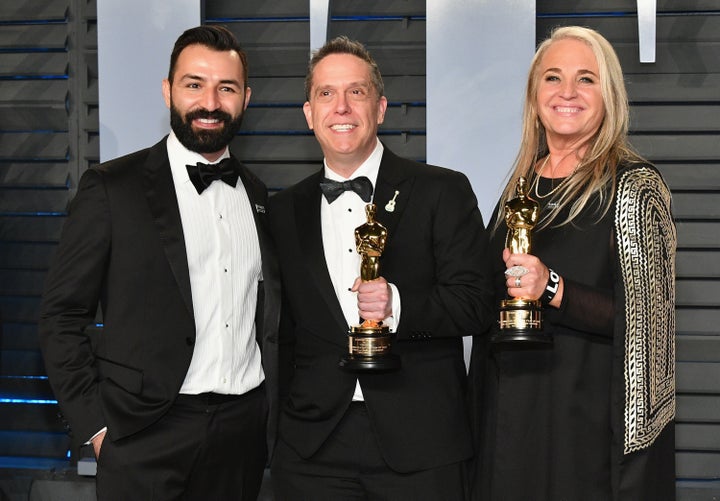
In his 11 years at Pixar, Adrian Molina has worked on some of the studio’s most beloved animated hits, including “Toy Story 3” and “Ratatouille.”
2017’s “Coco,” however, afforded Molina a different opportunity. The Oscar- and Golden Globe-winning film is deeply centered on Latino traditions, following a 12-year-old boy, Miguel Rivera, who finds himself transported to the Land of the Dead after his traditional family disapproves of his passion for music.
Set on the Mexican holiday of Día de los Muertos (or “Day of the Dead”), “Coco” allowed Molina ― who co-wrote the movie’s screenplay with Matthew Aldrich ― to tap into his own Mexican-American heritage. Before production on the film wrapped, Molina had been promoted from the film’s co-screenwriter to serve as its co-director alongside Lee Unkrich.
“Coco,” of course, was a critical and commercial smash, besting 2012’s “The Avengers” to become Mexico’s top-grossing film of all time. Molina, meanwhile, made waves once again at the Academy Awards in March when he thanked his husband, Ryan Dooley, while accepting the Oscar for Best Animated Feature alongside Unkrich and producer Darla K. Anderson. (Anderson also thanked her wife, Kori Rae.) The moment was viewed as a subtle but significant showcase of LGBTQ lives on the global stage.
Molina, 32, told HuffPost his many “overlapping” identities have been influential in his work as an animator and filmmaker.
“Having grown up where ― at multiple times for multiple reasons ― I had an inner conflict, and I didn’t know exactly how to vocalize how I was feeling, it made me empathetic to the fact that you never really know what’s going on in someone’s life,” the California native said. “Having lived that experience really allowed me to be in tune with the human spirit and the struggles that can go unspoken.”
Currently developing ideas for his next film, Molina spoke with HuffPost about his big Oscars moment, his hope for a queer-inclusive Pixar film, and the type of LGBTQ representation he’d like to see in Hollywood.
“Coco” is regarded as such a benchmark in Hollywood in terms of Latino representation. What parts of your personal experience did you incorporate into the film?
A lot of it was a sense of getting the family in a place where it felt real. I really wanted the sense of a multigenerational family and how that dynamic works to translate into [the character of] Miguel’s family. I don’t think that’s a thing that’s necessarily unique to Mexican culture, but it was my experience for a certain part of my upbringing. I know so many instances where you’ll have grandparents, parents, grandchildren, everyone under the same roof.
So, to be able to get that sense of many generations interacting, looking at the world differently … was something that we felt worked very much in terms of the theme of remembering the people who came before you and knowing how you fit into that chain of family.

How do you hope the film’s inclusive message resonates with queer audiences specifically?
I think the struggle Miguel goes through ― between having this personal passion, this intuitive sense of the person he is, but being unable to show that, and the way he works through his conflict ― [can speak] to the journey of a queer person.
In an interview after the Oscars, producer Darla K. Anderson said an LGBTQ-inclusive Pixar film would be “a dream.” At this point, what do you think it would take for an animated family film with a queer protagonist or angle to get the green light?
I’m exactly of the same mindset. ... I think you’d have to have someone with a really great idea. It would have to be a compelling story that had universal appeal. There are so many beautiful stories to be told and so many characters to explore. I’m all for it.
Watch Anderson speak about the possibility of a queer Pixar film. Story continues below.
You and Anderson both generated a lot of buzz for thanking your respective same-sex partners in your Oscars speech. Did you feel it would be interpreted as a subversive act?
I’ll put it this way: I’m a gay Mexican-American artist. I’m proud of all of those things; I claim all of those things. That’s literally just me showing up every day. Whether it’s subversive or whether it’s not, I don’t really have a choice in the matter. But I’m just going to show up as who I am every day, and be happy that I’m able to do that.
How did you navigate your queer identity growing up?
The fear of growing up different can work in multiple directions. When you’re growing up Mexican in a place where a lot of Mexicans aren’t, you can feel like an other outside of the home, but you feel like yourself inside of the home. At the same time, you could be growing up queer inside that home, and feel like an other in a different way. I think that one experience informs the other.
Fortunately, I come from a family where, when I came out, it was those strong family values ― and I mean that in the sincerest, purest form ― that made that transition to coming out so much easier. At that moment, it was all about, “You are our family, we love you. Of course this is fine.” I credit that to my sense of the importance of family. When put to the test, the values of my community and my family really proved themselves to be about love. I’m lucky in that respect.
I’m of Mexican heritage, I’m queer, I’m an animation nerd, I’m an artist. The fact that those things sometimes overlap and sometimes don’t is a good thing. I think when you’ve got a diverse family, a diverse household in terms of age, gender, race … you find that a variety of experience really does set you up to be very empathetic and thoughtful if you’re open to it.

When you were growing up, whom did you look up to in the queer community?
I didn’t come out until I’d already started working at Pixar, and my very first producer was Darla K. Anderson. She was an out, powerful and vocal woman in a crazy, creative workspace. Being able to show up at a studio and see her as an example of someone who was just being herself and doing a great job [helped me realize] that this is possible. Having that freedom and safety really allows you to do great work.
When I was growing up, I don’t know if I had a lot of role models on my radar, although RuPaul would pop up in a lot of movies that I liked! [Laughs.] There’s a thread of RuPaul in many of the films I grew up on.
“As humans, we all feel pain, sorrow and longing, in addition to joy, elation and connection. These, I think, are things we find comfort in knowing are common across cultures, identities and experiences.”
- Adrian Molina
You and your husband, Ryan, were quoted in a 2010 New York Times article about marriage equality. What role do you think artists play in moving the conversation on LGBTQ rights forward?
Storytelling can have a transformative effect. In creating “Coco,” you see that effect in people who have never seen themselves represented on screen in the way they experience their own lives. To finally have this Latino family that exemplifies everything that we, as Latinos, love about our families feels transformative.
The purpose of storytelling is to be able to inhabit many experiences. As humans, we all feel pain, sorrow and longing, in addition to joy, elation and connection. These, I think, are things we find comfort in knowing are common across cultures, identities and experiences.
What do you see as the next hurdle for LGBTQ representation in film?
What I’d love to see is the diversity of stories that can exist about queer people. Many people have this experience in many different ways. I want to see many interpretations of that. I think that’s possible. There are plenty of brilliant artists who are up to that challenge. Even having to define it as queer storytelling ― it’s all just storytelling. I’d love to see so much of it you can’t quantify it.
For LGBTQ Pride 2018, HuffPost is highlighting 30 different cultural influencers who have shifted the narrative when it comes to queer issues and whose work has contributed to building a more inclusive and equitable future for us all.
#TheFutureIsQueer is HuffPost’s monthlong celebration of queerness, not just as an identity but as action in the world. Find all of our Pride Month coverage here.
